Abstract
To improve laser anti-UAV technology and UAV laser protection capabilities, research on continuous laser damage to a UAV flight control system has been carried out. Combining waveform and function monitoring, the performance of the flight control system under laser irradiation was observed in real time, and the temperature and ablation process were recorded, which were used to analyze its damage characteristics and thresholds. Our experimental results show that the flight control system had two damage modes: temporary failure and permanent damage. Temporary failure had a temperature threshold, which was on average K. All temporarily failed flight control system functions could be restored after cooling and a manual restart, but permanently damaged flight control systems could not be manually restarted. This experiment showed that, within K. All temporarily failed flight control system functions could be restored after cooling and a manual restart, but permanently damaged flight control systems could not be manually restarted. This experiment showed that, within , the power density required for temporary failure and permanent damage to the flight control system was and , respectively. The power density required for permanent damage was within if the flight control system was encapsulated with aluminum alloy. Based on the circuit fault diagnosis of the flight control system samples that has been permanently damaged, the laser’s thermal effects damaged the diodes and linear regulators, ultimately rendering the flight control system unable to be manually restarted.
1. Introduction
Laser anti-drone technology has received widespread attention in the fields of homeland defense and civil security [1,2]. To improve the effectiveness of laser anti-UAV, it is necessary to analyze the characteristics and threshold values of the important internal core components of UAV under laser attack. Early research on laser damage focused on laser-resistant materials [3] and detector damage [4,5]. As the power of lasers gradually increased, laser damage to drone blades, motors, and flap control systems gradually emerged, but there were few studies in the related literature, which only provided damage images without disclosing the specific research process and results [6]. In addition, there have also been related studies on the laser irradiation of liquid tanks, which have mainly explored the effect of the boiling state of the liquid on the damage to the laser irradiated tank shell [7]. These all fall into the category of laser damage to drones, but the location of the drone irradiated by the laser is different. The flight control system is the core component of the UAV, and its importance is equivalent to the “brain” of the UAV [8]. However, there is an absence of research on the damage characteristics of the core components inside the drone after the laser melts through the drone shell. Studying laser irradiation in UAV flight control systems is crucial for vulnerability analysis [9,10] and the establishment of damage probability model.
Flight control systems suffer from the risk of temperature increases and even fire under the thermal effect of the laser, resulting in unexpected losses in operational performance. When the temperature of the circuit board exceeds the melting point of tin, the melting of tin may cause short circuiting or the cross-connection of adjacent pins. Elevated temperature will also aggravate the thermal expansion mismatch between materials, increase the thermal stress of the solder joint, and cause the solder joint to fail [11]. Under burning conditions, the insulation material will pyrolyze and release gases. The charred insulation material is conductive and will interfere with the insulation properties required of the PCB. In addition, the gases generated by combustion will also pollute the circuit environment and arcs may form between different potentials [12]. Although circuit boards have been known to suffer damage from exposure to heat and combustion, there is currently a lack of clear understanding of how the UAV flight control system can be damaged by the thermal effects of lasers. The laser power density damage threshold of the flight control system and the damage time threshold of its various functions have not been reported on yet.
Based on the above considerations, a damage experiment on a UAV flight control system under continuous laser irradiation was carried out, which focused on analyzing the damage characteristics and thresholds of the flight control system, as well as comparing the threshold changes after packaging. Compared with previous experiments on laser damage to UAVs, this experiment had two significant differences. Firstly, the target components of laser irradiation were different, and this study focused on the flight control system of the UAV. Secondly, there were innovations in our experimental methods. The laser damage experiment of the flight control system was a non-static functional damage experiment. During laser irradiation, the flight control system maintained normal operation, and multi-functional monitoring equipment was used to monitor and observe the damage in real time. This experimental method focused on functional damage, which is significantly different from the laser damage experiment method for UAV blades, engines, and fuel tanks. After the experiment, circuit fault diagnosis was performed on the permanently damaged samples to identify the source of the faults, providing crucial data for enhancing the anti-laser damage design of flight control systems.
2. Experiment
2.1. Experimental Instrument
The experimental setup is illustrated in Figure 1. The wavelength of the continuous laser used in the experiment was . The laser model, SMATLas-4S-030HC, has a maximum power of 3000 W and allows for software-controlled adjustment of the output power. The laser is divided into two beams by a beam splitter. The reflected beam reaches a power meter which measures the irradiated power on the target. By adjusting the focal length of the beam expansion system, shifting the lens position, or adding additional lenses, the spot diameter on the target was carefully adjusted to reach , which was sufficient to cover the flight control system. The spot radius was measured using a beam quality analyzer, model SP620U. All of the electronic components of the flight control system are situated in the front, while only some of the wiring is on the back. The back is a laser irradiated surface to simulate the ground-to-air defense scenario. The thermal imagers monitor the temperature of the front and back of the flight control system, and a camera is utilized to record the damage process of the back of the flight control system.
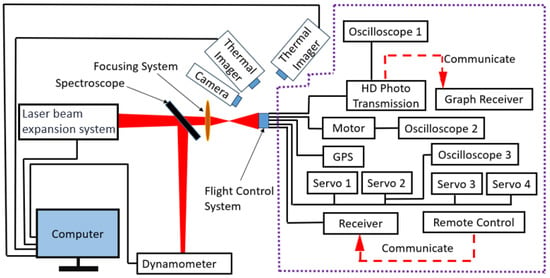
Figure 1.
Experimental optical path design of laser irradiation of flight control system.
The flight control system sample adopts a 4-layer board structure design, with a board material of FR-4, a board thickness of , and a copper thickness of 1 oz. A 1 oz thickness is achieved by evenly laying of copper over a 1 square foot area. The manufacturing technique involves lead-free tin spraying, green oil, white text, and through hole cover oil. The flight control system is packaged in 6061 aluminum alloy, with a thickness of 1 mm and no paint. The flight control system has no contact with the bottom of the packaging box, and four columns are utilized to fix the flight control system. The packaging material is based on a certain type of fixed-wing UAV, and the flight control system and packaging box design are shown in Figure 2.

Figure 2.
Laser irradiated subjects: (a) Flight control system model, (b) Aluminum alloy packaging box model.
2.2. Flight Control System Damage Characteristics Test
During laser irradiation, to reproduce the true state of the flight control system, the drone remote controller continuously inputs control commands, and the image transmission receiver receives video signals, including attitude, GPS coordinates, altitude, and other data. To monitor the gyroscope, a centrifugal vibration device is installed to evaluate its working status by receiving image transmission video feedback, and a camera is utilized to record the working status of the motor and servo connected to the flight control in real time. At the same time, the oscilloscope monitors the motor, servo, and high-definition image transmission signals, as illustrated in Figure 1. The motor speed is measured by a blade tachometer, and the servo deflection angle is measured using a ruler to detect possible intermediate process states, such as the motor speed not reaching the set value or the servo deflection not reaching the preset angle.
After laser irradiation, the internal circuits and electronic components of the flight control system are tested according to the design drawings, including important wiring, all resistors, all capacitors, and some electronic devices. The conduction of the line inside the flight control system and the change of the resistance value of the resistors can be tested with a multimeter. The capacitance test is somewhat difficult, and the chip capacitor usually needs to be removed from the circuit for accurate measurement, so only the capacitor is tested for breakdown. The damage of some electronic components can be judged by appearance, such as some pins of the components falling off, completely falling off, and completely burning. The linear regulator input voltage is supplied by an external power supply, or TYPEC port, and the output voltage of the regulator is also tested.
2.3. Power Density Calculation
The experiment adopted a full coverage irradiation method. Based on Gaussian distribution, the actual power density to the target was calculated by integrating the rectangular area of the flight control system. As shown in Figure 3, the circular area is the irradiation spot, and the rectangular area is the flight control system.
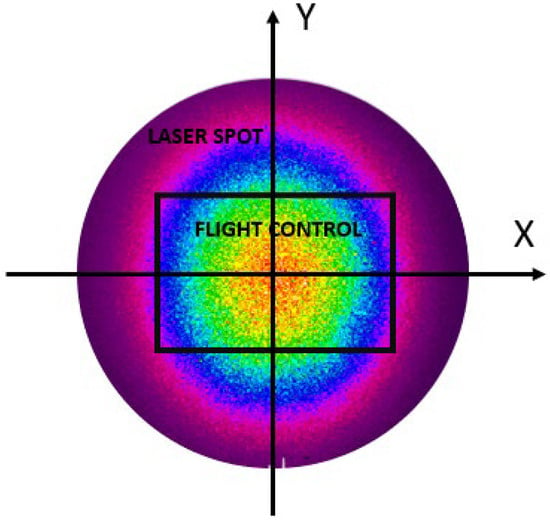
Figure 3.
Relative position of target spot and flight control system.
Within the size range of the flight control system, the average power density to the target can be expressed as:
where , and are known quantities. represents the laser irradiation power, which is measured by a power meter; and are the horizontal and vertical spot diameters corresponding to the measured spot at 2 times the variance, which are measured by the beam quality analyzer. represents the average variance of the horizontal and vertical coordinates. is the irradiation power to the target and is the average power density. and are the horizontal and vertical dimensions of the flight control system. and are distributed as the horizontal and vertical offsets of the center of the irradiation spot relative to the center of the flight control system, and and are half of the horizontal and vertical dimensions of the flight control system respectively. , , , , , and are measured via a ruler before the experiment. This power density calculation is mainly for the full coverage irradiation mode. Full coverage means that the diameter of the target point is greater than the longest diagonal length of the target, and the laser spot covers the target in space.
3. Experimental Results and Analysis
3.1. Ablation Damage
Figure 4 shows the damage picture of the flight control system irradiated by continuous laser by the 8th second, and Figure 5 shows the ablation morphology of the back side of the flight control system after 10 s of laser irradiation. Figure 6 shows the morphology of the front side of the flight control system after 10 s of laser irradiation. The phenomena of the flight control system being irradiated by laser included subtle smoke, high temperature carbonization, tiny flame, violent combustion, and continuous combustion. They correspond to five different average power densities of , , , , and , respectively, when the laser irradiation was and the spot diameter was . When the average power density of the target power was , white subtle smoke appeared above the flight control system, but no damage was seen on the surface of the flight control system. The volatilization temperature of solder paste flux was usually [13], and the maximum temperature on the back of the flight control system was Therefore, it can be presumed that the soldering flux volatilization caused the appearance of subtle smoke. The soldering flux was required for circuit board welding. When the power density was , the white smoke was obvious. After irradiation for , a small area of carbonization had appeared on the insulation layer on the back of the flight control system, and the internal copper foil was partially exposed, but no tiny flame appeared during the entire irradiation process. There was no carbonization on the front side of the flight control system, and there was tin melting and deformation on some device pins. When the power density was increased to , a tiny flame appeared at the center area of the back at the 6th second, dense smoke rose from the top, and a pungent odor was emitted. However, after the 10th second of irradiation, the tiny flame immediately extinguished. At this point, the radius of the carbonized area was about , and more copper foil was exposed in the carbonized area, while only slight carbonization appeared on the front of the flight control system. When the power density continued to increase to , the combustion became more intense, the radius of the carbonized area was about , and a large flame appeared, but the flame immediately extinguished after the laser irradiation stopped. Finally, at a power density of , the flight control system instantly caught fire in a large area at the 4th second, and the combustion was violent, accompanied by a lot of dense smoke and the splashing around of burning particles. After the laser stopped irradiating at the 10th second, the flight control system was still able to continue burning for . After the burning stopped, the carbonized area almost covered the entire flight control system, and interlayer cracks appeared. A considerable area of carbonization also appeared on the front of the flight control system, and at the right pin header, the signal line insulation material melted and deformed, virtually integrating with the pin header, and was difficult to separate after cooling.

Figure 4.
The damage picture of flight control system at 8th second of irradiation with different average power density to target: (a) , (b) , (c) , (d) , (e) .
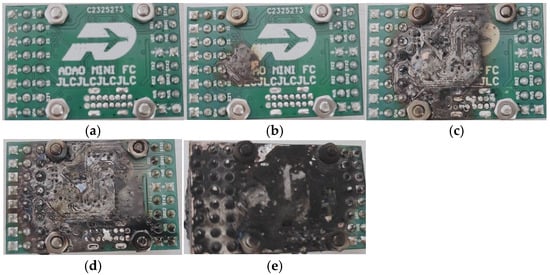
Figure 5.
Ablation morphology of the back side of the flight control system after laser irradiation stops with different average power densities to the target: (a) , (b) , (c) , (d) , (e) .
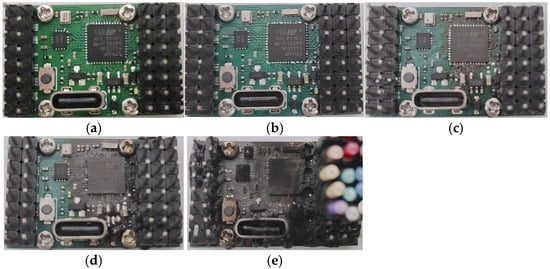
Figure 6.
Ablation morphology of the front side of the flight control system after laser irradiation stops with different average power densities to the target: (a) , (b) , (c) , (d) , (e) .
The temperature curve of the front and back of the flight control system under different irradiation power densities is given in Figure 7. When the power density was greater than , the temperature curve was significantly different from the curve at low power density. Because the power density was , the surface of the flight control system caught fire and released heat, which could further increase the surface temperature. The fire of the flight control system will cause the temperature curve to fluctuate. The temperature curve of the back in Figure 7a has no fluctuation. The reason for this is that the temperature rose too fast, and this fluctuation was relatively small. The fluctuation of the front temperature curve in Figure 7b was caused by the spread of the fire on the back to the front. On the other hand, the temperature of the back of the flight control system was the highest when the laser irradiation stopped, but the temperature of the front continued to rise after the laser irradiation stopped, and the duration was about . This showed that after the laser stopped irradiating, the back of the flight control system could still transfer heat to the front.
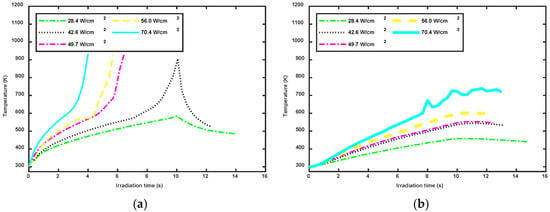
Figure 7.
Temperature curve of flight control system under different power density: (a) The back of the flight control system, (b) The front of the flight control system.
In summary, the power densities of subtle smoke, high temperature carbonization, tiny flame, intense combustion, and continuous combustion of the flight control system within of irradiation were , , , , and , respectively.
3.2. Functional Damage Characteristics
The functional monitoring of the flight control system is illustrated in Figure 8. The multiple experimental phenomena of laser irradiation UAV flight control system show that the flight control system has two behaviors: temporary failure and permanent damage. The temporary failure of the function is mainly manifested in the motor, servo, and image transmission signals becoming zero at the same time; the amplitude of the image transmission receiving signal gradually decreases; the servo becomes uncontrollable via the remote control and stops deflecting; the motor still rotates by inertia and gradually stops; in the received image transmission signal, the GPS latitude and longitude, gyroscope attitude, and flight altitude information stop updating; and the system power indicator light goes out. This shows that all functions of the flight control system stopped at almost the same time, and there was virtually no intermediate state process. Temporary failure means that after the laser stops irradiating, the system cools down to ambient temperature and the power is manually reconnected, all functions of the flight control system can then be restored, but the flight control system cannot automatically restart at ambient temperature. Permanent damage will also experience a temporary failure process, but after the laser stops irradiation, even if it cools down to ambient temperature, the flight control system still cannot manually restart, the system power indicator light no longer works, and all functions cannot be restored.
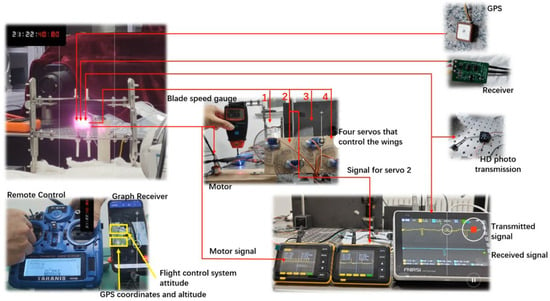
Figure 8.
Functional equipment monitoring before flight control system failure.
The experimental functional damage results are presented in Table 1. When the target power density is , the flight control system function does not fail within of irradiation, and its failure time is . Therefore, the laser irradiation time of this experimental group is . When the target power density is , the flight control system fails temporarily. When the target power density is greater than , the flight control system is permanently damaged. To evaluate the severity of the damage, combined with the ablation damage, the damage response of the flight control system to the laser power density within was divided into four different damage levels:
- No functional failure and no surface damage;
- Temporary functional failure, no surface damage;
- Temporary functional failure, minor surface damage;
- Function is permanently destroyed and the surface is seriously damaged.

Table 1.
Flight control system damage categories.
Table 1.
Flight control system damage categories.
| Average Power Density () | Damage Mode | Irradiation Time () | Failure Time () | Ablation Phenomenon | Damage Level |
|---|---|---|---|---|---|
| 14.0 | Temporary failure | 30 | 17.3 | Subtle smoke, no damage | I |
| 28.4 | Temporary failure | 10 | 7–9 | Subtle smoke, no damage | II |
| 35.4 | Temporary failure | 10 | 7–9 | Slightly carbonized | III |
| 42.6 | Permanent damage | 10 | 5–7 | High temperature carbonization | IV |
| 49.7 | Permanent damage | 10 | 5–7 | Tiny flame | IV |
| 56.0 | Permanent damage | 10 | 3–5 | Intense burning | IV |
| 70.4 | Permanent damage | 10 | 3–5 | Continued burning | IV |
To explore whether there was a temperature threshold when the flight control system fails functionally, the front and back temperatures of the flight control system at the time of failure were collected, as shown in Figure 9. The back failure temperature varied greatly and increased monotonically with the target power density, but the front failure temperature fluctuated in the range of K, and the average of 450.85 K was estimated to be the front failure temperature of the flight control system. The operating temperature of conventional electronic components was about K [14,15,16]. The first data point is closest to 423.15 K, and its front failure temperature is 431.15 K. Compared with other experimental groups, the temperature was lower, which may be because the low-power irradiation for allows the heat to diffuse more fully, resulting in a more uniform temperature.
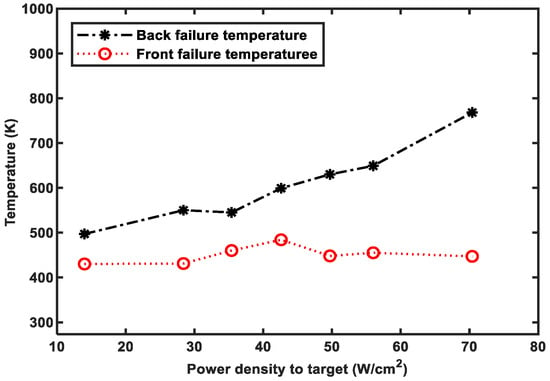
Figure 9.
Failure temperature of flight control system under different target power density.
To analyze whether there was delayed failure behavior, the flight control system was irradiated for at a power density of . When the laser irradiation stopped, the temperature on the front of the flight control system was only 431.15 K, and the function did not fail. However, after the laser irradiation stopped, the temperature on the front of the flight control system reached a maximum of 450.85 K, which is near the average failure temperature. The experimental results show that the flight control system functionally failed at after the irradiation stopped, and the front failure temperature was 443.15 K. This proves to be delayed failure behavior in the functional damage of the flight control system.
In summary, the power density required for temporary failure and permanent damage of the flight control system within is and , respectively. The product of the target power density in the rectangle of the flight control system and the failure time of the flight control system was taken as the energy density threshold for the flight control system temporary failure. The energy density threshold was , and the relative error was . According to the damage level of the flight control system caused by laser power densities of and , the energy density threshold for the flight control system permanent damage was .
3.3. Flight Control System Damage After Packaging
Unlike conventional post-target damage effect [17,18], the UAV flight control system after laser irradiation of aluminum alloy packaging mainly relies on thermal damage. One failure is that the packaging material absorbs part of the laser energy and converts it into heat energy, which causes the internal flight control system to heat up and fail through heat conduction. Another failure may be that the laser melts the aluminum alloy and directly irradiates the flight control system, and the packaging box has transferred some heat to the flight control system before the laser penetrates.
The emissivity of slightly oxidized aluminum alloy is 0.1–0.3, and that of strongly oxidized is 0.3–0.4. The literature shows that the emissivity of 6061 aluminum alloy is 0.15–0.2 at [19]. Through simultaneous testing with thermocouples and infrared thermal imagers, when the emissivity is 0.18, the two temperature curves are relatively consistent, indicating that the surface of the aluminum alloy is slightly oxidized.
In the three experiments after the flight control system was packaged, the laser irradiation was stopped immediately after the flight control system failed, and the damage categories are presented in Table 2. The ablation phenomenon did not show continuous burning, which may be related to the irradiation time and the low internal oxygen content after packaging. When the power density was , the functional failure time of the flight control system after packaging was , which was longer than that without packaging, indicating that the laser energy is mainly used to heat up the flight control system packaging box. When the power density was and , the failure time was and , respectively.

Table 2.
Damage categories of flight control system after packaging.
The real-time temperature of the package box is shown in Figure 10. When the flight control system fails functionally, the temperatures of the front and back of the package box are far beyond the failure temperature, which indicates that the front and back of the package box transfer heat to the internal flight control system at the same time. The functional failure of the flight control system may be caused by direct irradiation after the laser melts the aluminum. This is because the temperature of the back of the aluminum alloy has exceeded the melting point before the encapsulated flight control system has temporarily failed.
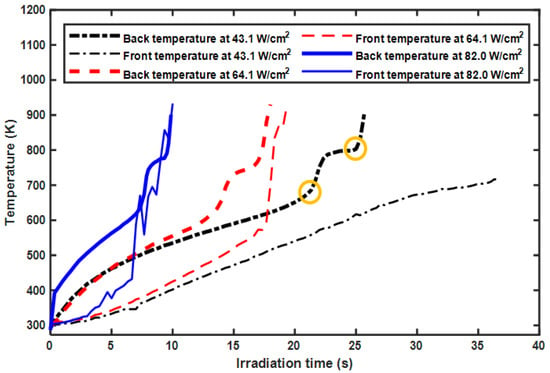
Figure 10.
Temperature curves of the front and back surfaces of the aluminum alloy packaging box at different power densities.
Unlike the conventional laser irradiation results of aluminum plate, the temperature rise on the back of the flight control system package box has two mutations, as shown in Figure 10. The two mutations of one temperature curve are marked with orange circles. To analyze the reason for this, different radius spots were selected to irradiate aluminum targets. The large spot had observable temperature rise mutation, while the small spot had almost no mutation, as shown in Figure 11. Therefore, the first mutation is caused by the accumulation of heat at the edge of the sample size when the spot size is too large and cannot be diffused. Based on the literature [20,21], the second mutation is caused by an abrupt change of resistivity of the aluminum alloy during the solid–liquid phase transition, which causes the absorptivity to increase suddenly.
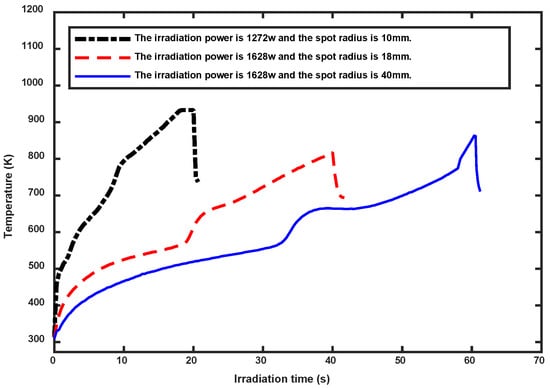
Figure 11.
Temperature curve of aluminum plate irradiated with different spot radius.
To compare the temperature of the box containing the flight control system and the empty shell, the empty aluminum alloy shell was irradiated with a power density of . The experimental results are shown in Figure 12. The temperature of the back of the packaged aluminum alloy is lower than that of the empty shell, but the temperature of the front is higher. This shows that the flight control system can promote the transfer of heat from the back to the front, similar to the laser ablation phenomenon of laminates [22,23], in which the heat transfer is blocked, resulting in a high temperature on the irradiated surface and a low temperature on the opposite irradiated surface.
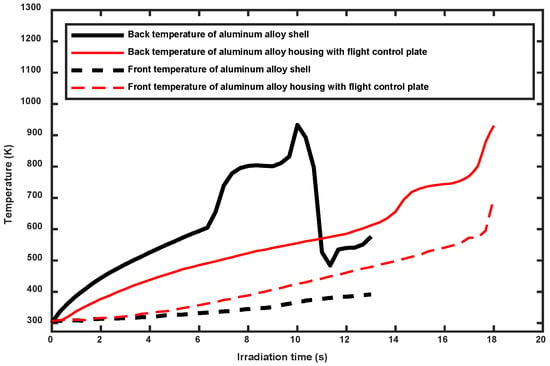
Figure 12.
Temperature curve of the flight control system after packaging and the empty package.
The functional failure energy density threshold of the packaged flight control system is , with a relative error of .
4. Electronic Damage Characteristics
To evaluate the internal damage of the flight control system after laser irradiation, samples with permanent functional damage were selected for testing, excluding those with severe damage that could not be tested. After screening, four damaged samples were finally selected, corresponding to the experimental groups with power densities of , , and without packaging, and after packaging.
After testing, it was found that all the functional failures of the flight control system were primarily caused by the disconnection of the internal core power supply. In the three groups of samples with a spot diameter of and power densities of , , and , the flight control system had linear regulator damage or the pin of the reverse DC withstand voltage diode fell off, resulting in the inability to provide a input voltage to the voltage regulator, and ultimately causing the voltage regulator to be unable to provide a voltage to the main control chip. In addition to the disconnection of the flight control system power bus, the wiring and some electronic components will be more seriously damaged as the power density increases. The circuit damage categories include line disconnection, capacitor breakdown, linear regulator damage, Reverse DC diode failure, Capacitive breakdown, Pin off, Pin mixing, Component burnout, Resistance change, and the Cascade effect. The number of different types of circuit damage is shown in Figure 13. In all three test groups, line disconnection occurred, but these lines did not include the core power line, and their disconnection did not disable all functions of the flight control system. Apart from line disconnection and core power supply failure, other damage categories occurred in only some of the test groups, but not in all of them. Therefore, the failure of the core power supply caused by damage to the reverse DC withstand voltage diode and linear regulator is considered to be the main reason why the flight control system cannot be manually restarted.
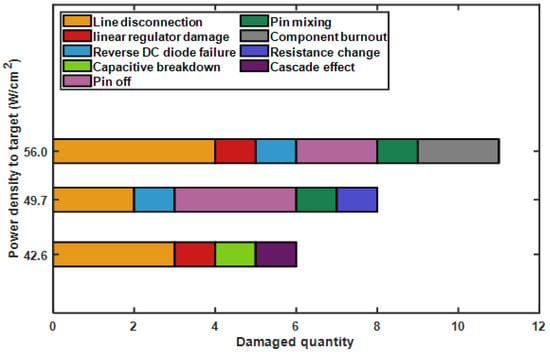
Figure 13.
The damage number of different types to the internal circuits of the flight control system.
In the experimental group with a power density of after packaging, the damaged samples did not appear to be seriously damaged, and most of the electronic components were even intact, as shown in Figure 14. However, the damage level of the sample was still IV, and the flight control system function was permanently damaged. After testing, it was found that the pin of the reverse DC withstand voltage diode was damaged, resulting in an inability to input to the linear regulator, which may be the reason for the initial failure of the flight control system. To verify this hypothesis, the TYPEC port was used as a power supply to avoid the current passing through the reverse DC withstand voltage diode. By providing a voltage through the TYPEC port and powering external devices at the same time, all functions of the flight control system could be restored, so this phenomenon verifies the above hypothesis, and also further explains that the failure of the flight control to restart is mainly caused by damage to the linear regulator or reverse DC withstand voltage diode.
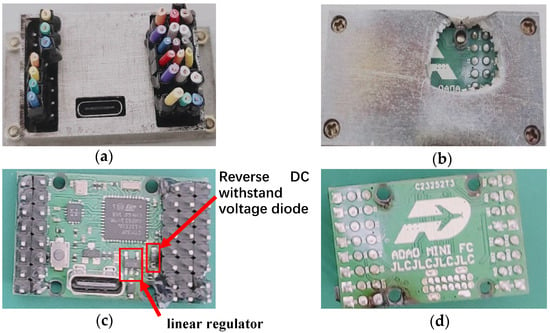
Figure 14.
Damage morphology of the flight control system package box before and after disassembly when the power density is : (a) Front of the package box, (b) back of the package box, (c) Front of the flight control system, (d) back of the flight control system.
5. Conclusions
An experiment of continuous laser damage to the flight control system of a UAV was carried out. As the laser energy accumulates, subtle smoke, high temperature carbonization, tiny flame combustion, violent combustion, and continuous combustion can be observed on the surface of the flight control system, and they correspond to the laser power densities of , , , , and , respectively, within . In addition to traditional laser ablation of materials, there are two functional damage modes of the flight control system: temporary failure and permanent damage. The laser energy density damage threshold for temporary failure is , and the temperature threshold is about 450.85 K. Permanent damage to the flight control system can also go through a temporary failure process, the energy density threshold for permanent damage is . When the flight control system is packaged in aluminum alloy, the energy density threshold for temporary failure is . After the circuit fault diagnosis of the flight control system with permanent damage, the flight control system cannot be manually restarted, mainly due to damage to reverse DC withstand voltage diode and the linear regulator. Damage to these components ultimately result in an inability to power the main control chip of the flight control system.
Compared with the traditional laser damage experiment, this experiment focused on functional damage under non-static conditions. When the laser irradiates the flight control system, it is ensured that the flight control system is in normal operation and its functions are monitored in real time. The temporary failure characteristics only appear when the laser irradiates the flight control system in a non-static state. In this experiment, laser irradiation does not need to reach ablation or destruction levels. It is only necessary to induce a temporary failure of the flight control system to cause the UAV to crash. If the traditional laser damage experiment design method is used, the function of the flight control system is only tested after laser irradiation, and the threshold of permanent damage can be determined, but it is difficult to capture the entire process of temporary failure. This limitation makes it impossible to fully observe the experimental phenomenon, and some experimental results are lost. Therefore, in traditional experiments, the damage threshold is often judged by permanent damage, but the threshold for temporary failure is more realistic.
Author Contributions
Conceptualization, L.L., S.C. and J.G.; methodology, L.L., J.W. and C.X.; validation, D.H., K.Y. and C.Z.; formal analysis, C.Z.; investigation, L.L., J.W. and C.Z.; resources, C.Z.; data curation, C.Z.; writing—original draft preparation, L.L.; writing—review and editing, S.C., C.X. and C.Z.; visualization, C.Z.; supervision, C.Z.; project administration, J.G.; funding acquisition, C.Z. All authors have read and agreed to the published version of the manuscript.
Funding
This research was funded by National Key Research and Development Program (grant number 2022YFE0121200).
Data Availability Statement
Detailed data acquisition can be requested via email from the first author at liule201@mails.ucas.ac.cn.
Conflicts of Interest
The authors declare no conflicts of interest.
References
- Zhu, M.Z.; Chen, X.; Liu, X.; Tan, C.Y.; Li, W. Situation and key technology of tactical laser anti-UAV. Infrared Laser Eng. 2021, 50, 20200230-1. [Google Scholar]
- Kaushal, H.; Kaddoum, G. Applications of lasers for tactical military operations. IEEE Access 2017, 5, 20736–20753. [Google Scholar] [CrossRef]
- Rahul, S.; Rajeev, V.; Rajiv, K.G.; Harpreet, S. Progress in aerospace materials and ablation resistant Coatings: A focused review. Opt. Laser Technol. 2024, 177, 111160. [Google Scholar]
- Titterton, D.H. Application of laser technology to optical countermeasures. Imaging Sci. J. 2010, 58, 286–294. [Google Scholar] [CrossRef]
- Zhang, Y.; Zheng, C.; Liu, Y.; Wang, Y.; Xu, Y.; Shao, J. Damage Mechanism of HgCdTe Focal Plane Array Detector Irradiated Using Mid-Infrared Pulse Laser. Sensors 2023, 23, 9370. [Google Scholar] [CrossRef] [PubMed]
- Taillandier, M.; Peiffera, R.; Colomerb, B.; Ortizb, R.; Chalumeauc, E.; Pommiesc, M. High-Energy Laser Experiments for Vulnerability Studies in the Context of the European TALOS Program. In High-Power Lasers and Technologies for Optical Countermeasures; SPIE: Bellingham, WA, USA, 2023; p. 12273. [Google Scholar]
- Jiao, L. Study of Laser Irradiation Effects on Liquid Tank. Ph.D. Dissertation, National University of Defense Technology, Changsha, China, 2019. [Google Scholar]
- Dong, Z.Y.; Zhang, W.Q. Drone Flight and Control, 11th ed.; Beihang University Press: Beijing, China, 2020. [Google Scholar]
- Liu, L.; Xu, C.Y.; Zheng, C.B.; Cai, S.; Wang, C.R.; Guo, J. Vulnerability assessment of UAV engine to laser based on improved shotline method. Def. Technol. 2023, 33, 588–600. [Google Scholar] [CrossRef]
- Pei, Y.; Song, B.F. Method for assessing unmanned aerial vehicle vulnerability to high-energy laser weapon. J. Aircr. 2012, 49, 319–323. [Google Scholar] [CrossRef]
- Zhou, Z.; Chen, J.; Yu, C.; Wang, Y.; Zhang, Y. Failure Analysis of Printed Circuit Board Solder Joint under Thermal Shock. Coatings 2023, 13, 572. [Google Scholar] [CrossRef]
- Slee, D.; Stepan, J.; Wei, W.; Swart, J. Introduction to printed circuit board failures. In Proceedings of the 2009 IEEE Symposium on Product Compliance Engineering, Toronto, ON, Canada, 26–28 October 2009. [Google Scholar]
- Li, T. Study on Flux Component of Snagcu Lead-Free Solder Paste and Its Effect on Corrosion Property of Solders. Master’s Dissertation, Xi’an University of Technology, Xi’an, China, 2009. [Google Scholar]
- TWGWC, 1N5817WS THRU 1N5819WS. Available online: https://datasheet.eeworld.com.cn/view/67220954.html?u_atoken=e7da4209c1d5f588be6c06671b0e1661&u_asig=2760821417216625961556744e449a (accessed on 13 June 2024).
- MicrOne, High Speed LDO Regulators, High PSRR, Low Noise, ME6211 Series General Description. Available online: https://file.elecfans.com/web2/M00/72/4D/poYBAGNVHsuAAvouABV6l3c8qJQ275.pdf (accessed on 13 June 2024).
- Guilin Strong Micro-Electronics Co.Ltd. S8050 Technical Specifications. Available online: https://wenku.baidu.com/view/fe73c3eb19e8b8f67c1cb9f3.html?fr=sogou&_wkts_=1723133736986&needWelcomeRecommand=1 (accessed on 13 June 2024).
- Peng, J.; Yuan, B.; Sun, X.; Chen, Y.; Chen, H. Research on Penetration Behavior and after effects of Coated Reactive Fragments Impacting Steel targets. Int. J. Multiphysics 2020, 14, 39. [Google Scholar]
- Yu, X.Y.; Yue, M.K.; Liang, Z.G. Numerical Simulation of Aftereffect Power of Shaped Charge JET Penetrating Steel Target. In Proceedings of the 2nd International Conference on Machine Learning and Computer Application, Dhaka, Bangladesh, 10–12 March 2022. [Google Scholar]
- Wang, W.B.; Zhang, K.H.; Yu, K. A comparative research on the infrared spectral emissivity of Al5052 and Al6061. J. Xingyi Norm. Univ. Natl. 2015, 4, 110. [Google Scholar]
- Wen, K.; Li, H.Z.; Ma, Z.; Gao, L.H.; Wang, F.C.; Li, W.Z. Effects of spot size on the temperature response of an aluminum alloy irradiated by a continuous laser. Chin. Opt. 2020, 13, 1023–1031. [Google Scholar]
- Wei, Y.B. Evaluation of Laser Target Damage Effectiveness. Master’s Dissertation, University of Electronic Science and Technology of China, Chengdu, China, 2019. [Google Scholar]
- Xiong, L.J.; Wang, J.W.; Nie, G.H. Analysis of Ablation and Strength of CFRP Laminated Structures under Laser irradiation. Chin. Q. Mech. 2022, 43, 771–781. [Google Scholar]
- Zhao, W.N.; Huang, Y.H.; Song, H.W.; Huang, C.G. Multi-Scale Analysis Model of Thermal-Mechanical Damage Effect in High-Power Continuous-Wave Laser Irradiation of CFRP Laminates. Chin. J. Lasers 2017, 44, 602003. [Google Scholar]
Disclaimer/Publisher’s Note: The statements, opinions and data contained in all publications are solely those of the individual author(s) and contributor(s) and not of MDPI and/or the editor(s). MDPI and/or the editor(s) disclaim responsibility for any injury to people or property resulting from any ideas, methods, instructions or products referred to in the content. |
© 2025 by the authors. Licensee MDPI, Basel, Switzerland. This article is an open access article distributed under the terms and conditions of the Creative Commons Attribution (CC BY) license (https://creativecommons.org/licenses/by/4.0/).